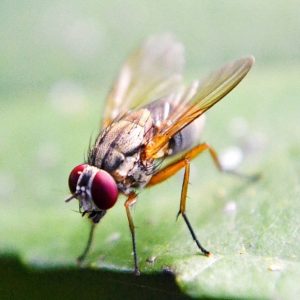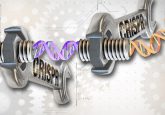Drosophila for diet strategies

What can the fruit fly tell us about optimal diet strategies and aging?10949
Matt Piper completed his BSc at the University of Adelaide (SA, Australia), his PhD in Biochemistry and Molecular Genetics at the University of New South Wales (NSW, Australia) and was a postdoctoral research and senior research fellow at University College London (UK), before moving on to Monash University (VIC, Australia).
Matt works on aging in Drosophila, in particular examining how diet affects lifespan and other life history traits. Dietary restriction (DR or calorie restriction) is an evolutionarily conserved intervention that extends healthy lifespan. Matt is interested in the nutrients and molecular mechanisms required to elicit this effect – in particular the role of protein. Knowledge of these interactions will aid understanding of the role of nutrient balance in adult health, appetite and longevity.
10957
Please can you provide us with a short overview of what your research entails?
We are interested in the way diet can affect almost any physiological outcome that could be classified as a health marker. Originally, this was with respect to longevity and aging but organisms are always balancing nutrition to optimize multiple traits simultaneously to make it fit for its environment. This means that we can manipulate the diet and end up with ways of manipulating many aspects of physiology.
So, we know we can very easily affect reproduction, for example. Immunity and lifespan are also things we’ve become interested in. We focus on how food modifies all of these traits, which are indicators of health.
Please can you tell us about your work using exomes to determine diet strategies?
We became very interested in the protein component of the food because, particularly for flies – although we also found it was relevant for mice –relatively high protein diets shorten life span.
In particular, high protein, low carbohydrate diets result in the shortest life spans; with the opposite also being true that low protein, high carbohydrate diets have the longest life span. These diets also inversely dictate the outcomes on fecundity. So, when the flies have a long life span, they have low levels of egg laying and vice versa.
We found that when we manipulated the quality of the protein in the diet, by altering the amino acid balance, it also moves those traits around – in particular egg laying. We then became interested in whether we could objectively define what is a balanced amino acid profile for high quality protein.
One way we could think of doing that was to simply ask the organism what it takes to make a new organism, looking at its genome sequence. So, we came up with this idea that in order for the fly to have enough amino acids in its diet for eggs, we could use the ratio of amino acids that is encoded by its own genome.
We took the genome of the fly, in silico translated the genome, summed up all of the individual amino acids, represented them as a proportion relative to each other and then used that ratio to put back into the food. This formulation resulted in the maximum number of eggs per gram of protein that we could deliver.
This idea, that we then termed exome matching, could be applied to any organism because you can take the genome of any organism and redesign its diet based on the amino acid proportions found from its in silico translated genome. When we did that for mice under protein-limiting conditions, we found that growth could also be predictably improved using this exome-matching technique.
It was a very simple idea that you just ask the genome of the organism what amino acids it requires to express all the proteins it encodes and then put that ratio back into the food. We find it gives the highest biological availability per gram of amino acid for any protein; more so than some naturally occurring proteins that the organism normally eats.
What has your research uncovered about the impact of diet on aging?
This was a really powerful way of driving early-life fitness traits, such as egg-laying and growth of mice or flies. We found that protein quality has very little effect on lifespan of the animals but the abundance of bulk protein, irrespective of the ratio of amino acids, was largely what dictated lifespan outcomes.
Even though we had this perfectly matched protein for egg-laying or for growth, if you had too much of it, there was still a cost to pay in terms of lifespan. More importantly, it challenged what standard evolutionary theory has told us about the mechanistic basics of aging: that egg-laying or fecundity is always inversely related to lifespan.
The fact that we can alter the diet to deliver low amounts of high-quality protein, which yields high levels of egg-laying, meant we could also optimize lifespan on the same diet.
So, which techniques are particularly useful in your research and what are the benefits of using fruit flies?
Bioinformatics is important. We have also spent a long time developing a synthetic diet for flies. There aren’t really any multicellular organisms that have a precisely defined synthetic diet so we made one for Drosophila that works really well for supporting adult egg-laying. That’s how we could find that manipulating these amino acids in very subtle ways could have large impacts on egg-laying, so that’s very important.
More recently, we are now interested in the molecular basis of how nutrition drives these traits; how flies make an egg once they’ve got the nutrients available to them. We’re now turning to more traditional molecular genetic techniques to manipulate the known growth signaling pathways in flies as well as the known nutrient acquisition pathways.
What are your research goals for the future?
On the exome matching side, a major goal for us is to work at adapting the technique so it becomes more sensitive to the individual circumstances of the organism that we’re feeding. For instance, if the organism is stressed in some way, we could perhaps adapt the diet to their nutritional needs from the genomic information, so that we can effectively try and treat them with diet.
Another thing we’re interested in is how odd non-ecologically-relevant balances of nutrients, for instance single amino acid depravations that you would never find in food in the wild, can elicit a stress response in the organism that then might be cross-protective against other stresses.





